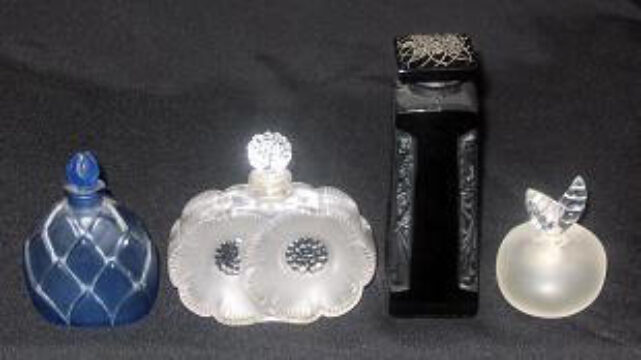
For its July Treasure of the Month, the Rosenberg Library displayed a selection of decorative glassware designed by Rene Lalique during the early 20th century. Rene Jules Lalique was born in France in 1860. At the age of sixteen, he began an apprenticeship for the well-known Parisian jeweler, Louis Aucoq. After attending the Sydenham Art College in London, England from 1878 – 1880, Lalique returned to France and began designing jewelry for top firms such as Cartier and Boucheron.

Early in his career, Lalique’s work was recognized for its Art Nouveau style. The Art Nouveau period was characterized by the use of naturalistic motifs and patterns with flowing, curved lines. Nymphs, peacocks, and dragonflies often appeared in Art Nouveau pieces along with various types of flowers and leaves. By the 1920s, the Art Deco style had begun to emerge, and Lalique’s designs reflected this change. Art Deco themes also included natural forms, but these were often highly stylized and geometrically precise.
During his career, Rene Lalique took advantage of what were, at the time, the most modern manufacturing techniques available. With the aid of more advanced technology and equipment, Lalique was able to produce multiple glass wares simultaneously. Lalique utilized assembly lines and reusable molds to manufacture his glass designs by the hundreds, and even the thousands. Despite being machine-manufactured, Lalique’s glass and jewelry maintained its quality and handmade appearance. Since it was much less expensive to produce, Lalique glass was often affordable to the general public.

After Rene Lalique’s death in 1945, his son, Marc Lalique, took over the company. Today, Rene Lalique’s grand-daughter, Marie Claude Lalique, is the firm’s head designer. Lalique continues to produce beautiful jewelry and decorative glass and has stores located around the world. The value of vintage Lalique glass has steadily risen over the years due to its growing popularity among collectors.
Photo Captions:
1. Lalique vase in the “Sylvie” pattern.
2. Lalique vase in the “Bacchantes” pattern.
3. An assortment of perfume bottles designed by Lalique.
From the New York Times online June 23, 2011:
Suddenly, Lalique Is Back in Vogue